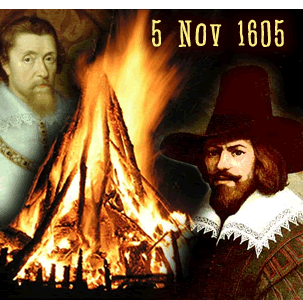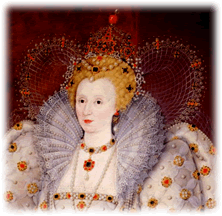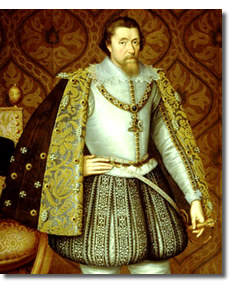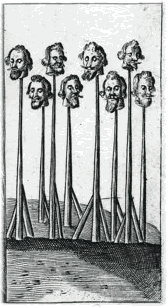

England's
Gunpowder
Plot of 1605
Guy Fawkes Day
Recalls a Bye-Gone Age
of Religious Terrorism.
By Ronald Fritze
Posted on November 4, 2008, from Athens, Alabama
Cloaked with zeale of Superstitious Religion,
aymed in deed at the Subversion of the State,
and to induce an horrible confusion of all things.
Proclamation of James I against the Gunpowder Plotters,
7 November 1605.
It used to be common in England that as the fifth of November approached, children would stand on street corners with stuffed figures of a man and ask passers-by the question, ďA penny for the Guy?Ē The Guy in question was an effigy of the arch-traitor Guy Fawkes. When the evening of November 5th arrived,
 all the Guys would be taken to an area of bonfires and burned in ceremony.
all the Guys would be taken to an area of bonfires and burned in ceremony.
The holiday
known as Guy Fawkes Day commemorates the foiling of a plot by Guy Fawkes and other Catholic extremists to blow up King James I and his Parliament in 1605. To this day yeoman warders search the Houses of Parliament at the opening of Parliament for explosives. This holiday and its rituals have been repeated in differing forms for over four centuries, but they have their origins in a very tense and nervous time in English history.
War, Depression, Famine, Disease
In 1600 England was facing an uncertain future fraught with various dangers. It was a time of bad news on multiple fronts.
The war with Spain began in 1588 with the great victory over the Spanish Armada, but the conflict had continued to drag on for over a decade with fading hopes of decisive victories.
Economic depression developed as the war drained Englandís manpower and treasure while it stifled trade.
Bad weather caused poor harvests, and poor harvests lead to famine. Famine weakened the populationís resistance, leading to epidemics of contagious disease.
Englandís war with Spain prompted the restive Irish to rebel in 1594 under the leadership of Hugh OíNeill, the earl of Tyrone. His skillful leadership prevented the English from
 suppressing the rebels. Even Queen Elizabethís favorite, the dashing Robert Devereux, the earl of Essex, proved unequal to the task of defeating Tyrone. Instead he let Tyrone wear down his army of sixteen thousand men in a matter of twenty-one weeks during 1599 and promptly abandoned his command to return to London, much to the dismay of Elizabeth I.
suppressing the rebels. Even Queen Elizabethís favorite, the dashing Robert Devereux, the earl of Essex, proved unequal to the task of defeating Tyrone. Instead he let Tyrone wear down his army of sixteen thousand men in a matter of twenty-one weeks during 1599 and promptly abandoned his command to return to London, much to the dismay of Elizabeth I.
Ireland appeared lost,
but thanks to the generalship of Charles Blount, Lord Mountjoy, both the Irish and a relief expedition of Spanish troops were defeated at Kinsale in 1603. Ireland remained an English possession but just barely.
 Meanwhile, Elizabeth
Meanwhile, Elizabeth
in 1600 had been queen for over forty years and was now in her late sixties. Yes, she had lived significantly longer than her grandfather, father, brother, and sister. But that didnít matter much to the queen, who raged against old age and refused to admit that her death was approaching. She also refused to clarify her wishes concerning the issue of succession, choosing to spend her energy in a May-December flirtation with the Earl of Essex. Many of her subjects were scandalized, while others were positioning themselves for the succession. Most people assumed her successor would be James VI of Scotland, although other plausible claimants waited their opportunity.
Elizabeth I had lingered too long on the stage of history. Her people longed for a change.
International Religious Conflict
Pits Protestant against Catholic
Englandís war with Spain symbolized a wider struggle between Protestant and Catholic powers in Europe. Within England, a Catholic minority kept the Protestant majority nervous. Were the Catholics traitors in the midst of their own country? Would they help cruel Spanish armies to invade England and reestablish Catholicism? Most English Catholics vehemently denied these charges, but a few harbored irreconcilable grievances.
The English government was also divided by the competition between William Cecil and his son Robert on the one side and the ambitious and arrogant Earl of Essex on the other. By 1600 Essexís star was fading. His failure and dereliction of duty in
 Ireland had lost him the regard and favor of Queen Elizabeth, who began to rescind the privileges and sources of wealth she had bestowed on him.
Ireland had lost him the regard and favor of Queen Elizabeth, who began to rescind the privileges and sources of wealth she had bestowed on him.
Threatened with ruin, Essex decided to purge Elizabethís government of his enemies through a coup díetat, even if it meant taking her prisoner. His preparations aroused suspicion, forcing him to launch his coup without much hope of success on 8 February 1601. It failed in a single day. The authorities arrested Essex, who was swiftly tried and just as swiftly executed on 25 February.
With the elimination of Essex, Robert Cecil became the supreme power in the Elizabethan court. But the attempted coup and its violent aftermath had severely shaken the Queenís health. She began to deteriorate noticeably, even as she remained in denial about her mortality, and doggedly clung to life. When at last she died on 24 March 1603, the succession of James VI as James I of England proceeded smoothly on the surface. Underneath raged a torrent of discontent and intrigue.
James I, like Elizabeth I, faced the problem of war with Spain, a costly and lingering conflict with no apparent end in sight. The new king had some difficulty recognizing that England was not
 nearly as wealthy a kingdom as he thought it was.
nearly as wealthy a kingdom as he thought it was.
Unlike Elizabeth,
James I bore the political problem of being Scottish. Adversaries for centuries, England and Scotland disliked one other intensely, harboring deep cultural prejudices and widespread political mistrust. James also bore the burden of hope that accompanies any major political change. The coming of a new monarch created optimism among both English Catholics and radical Protestants that James I would change their circumstances for the better. They were bound to be disappointed.
Some became disappointed almost immediately. Two conspiracies, one Catholic and the other Protestant, were in full development by the summer of 1603.
The Protestant conspiracy, known as the Main Plot, consisted of a plan by Lord Cobham to replace James I as king of England with his cousin, Arabella Stuart. Itís likely that the conspirators would have killed James I and his family. After the plot failed, Sir Walter Raleigh was implicated and convicted along with Lord Cobham. Raleighís guilt is doubtful, but in the end it didnít matter. Both he and Cobham were pardoned on the scaffold.
The Catholic conspirators were not so lucky. Their plan, known as the Bye Plot, originated with the secular priest William Watson, who was profoundly disappointed by James Iís failure to immediately reduce the penal laws that oppressed English Catholics. The plan envisioned the kidnapping of James I, who would be forced during captivity to overturn the oppressive laws against Catholics. An uprising was planned to coincide with the kidnapping.
The plot failed after Jesuits betrayed the conspirators to government officials. The traitors were tried and convicted — and this time, James I showed no mercy. The Catholic conspirators, the priest Watson, and sympathizer George Brook were savagely executed.
With plots against his rule launched by both Catholics and Protestants, King James I, somewhat timid to begin with, became seriously apprehensive about his security.
1604 brought peace with Spain but no legal relief to the Catholic minority of England, although James I was not particularly interested in persecution. Still, a small group of Catholic extremists remained disgruntled and alienated from their government and their countrymen. Hence the third and most memorable plot, the one that gave rise to a lasting holiday.
Although Guy Fawkes is the plotter commonly remembered today, the real leader of the conspiracy was Robert Catesby. A member of a Catholic family of Warwickshire, he was also a descendent of William Catesby, the minister of Richard III who was executed in the aftermath of the Battle of Bosworth Field. Robert had good reason to resent the crown.
Robert Catesby had paid dearly for his participation in the Essex Rebellion of 1601, suffering imprisonment and ruinous fines on his estates. The persecutions of his fellow Catholics also aroused his ire. When the accession of James I brought no relief, Catesby conceived a plan to blow up James I and the English Parliament. In the aftermath of death and destruction, he would rise from the ashes to reestablish Catholic rule.
Let's Blow 'Er Up.
On 20 May 1604 he unveiled his scheme to other disgruntled Catholics at the Duck and Drake Inn along the Strand in London. His fellow conspirators at that time were Thomas Winter, John Wright, Thomas Percy, and Guy Fawkes.
Fawkes was born into a Protestant family, but he converted to Catholicism and fought in the Spanish army against the Dutch rebels in the Netherlands. Most importantly to the conspiracy, Fawkes was a man who knew gunpowder.
The group ultimately expanded to the ill-omened number of thirteen.
Thomas Percy, one of the thirteen, was a relative of Henry Percy, the ninth earl of Northumberland. Thomas also collected rents for the Earl, making him a trusted servant. In fact, the Earl secured Thomas Percy a position as a gentleman pensioner without having Thomas swear the Oath of Allegiance, something that would have presented a genuine ethical dilemma for a good Catholic. That favor would come back to haunt the Earl, who would eventually be accused of being part of the Gunpowder Plot and punished with imprisonment in the Tower of London for sixteen years — all for doing a favor for a relative. Let it be a salutary lesson for us all.
The plotters sought to rent a house next to the Houses of Parliament so they could tunnel under the building and place gunpowder underneath it. This plan represented a significant and difficult mining operation. Fortunately for Catesby and his fellows, they got an opportunity to rent a storage room right under the Parliament building, which saved them from having to complete their tunnel. Gradually they filled the room with gunpowder, which was in great surplus because the war with Spain had recently ended with the signing of the Treaty of London. What weaker allegiance than an arms merchant?
The band of thirteen managed to place some thirty-six barrels of gunpowder in the storage room. After being some eighteen months in the making, it appeared for a brief moment that the plot might work, that the Parliament buildings would be obliterated, that the neighborhood around it in Westminster would be devastated, and that the path to power would be paved in a thundering flash of fire and smoke.
Events both human and political soon spoke otherwise, turning and twisting in unexpected ways against the gunpowder plotters.
Some of the conspirators faced issues of will brought about by qualms about blowing up the Catholic lords who would be in Parliament on the fateful day. Someone went so far as to warn the Catholic Lord Monteagle by sending him a letter on 26 October 1605. The shaken young lord promptly took the letter to Robert Cecil, the earl of Salisbury and James Iís chief minister. Although Cecil did not take the warning particularly seriously at first, the governmentís suspicions were aroused.
Then on the night of 4 November and the early morning of 5 November, a search party lead by Sir Thomas Knyvett discovered Guy Fawkes in the storage room with all that gunpowder. A great act of terror had been prevented.
 As the authorities interrogated Fawkes under torture, they began to gather details of the conspiracy. Their information led them to the village of Holbeach, where the conspirators had decided to make a stand. During the ensuing fight, Thomas Percy, Robert Catesby, and some others were killed or mortally wounded. The rest were taken prisoner. They would later be tried and gruesomely executed by hanging, drawing, and quartering.
As the authorities interrogated Fawkes under torture, they began to gather details of the conspiracy. Their information led them to the village of Holbeach, where the conspirators had decided to make a stand. During the ensuing fight, Thomas Percy, Robert Catesby, and some others were killed or mortally wounded. The rest were taken prisoner. They would later be tried and gruesomely executed by hanging, drawing, and quartering.
For James I and the English Protestants, death and loss of power were averted. They had been saved again. And a frightful resurgence of Catholicism in England had been prevented.
The Gunpowder Plot ended in a stillbirth, but it was not to be forgotten. In late January 1606, Parliament passed a statute entitled ďAn Act for a Public Thanksgiving to Almighty God Every Year on the Fifth Day of November.Ē It began a tradition of celebrating the deliverance of England from the Gunpowder Plot that has lasted to the present.
From Medieval Bonfires
to a Mirror of Halloween
The celebration has evolved and changed over time. Initially a religious service of thanksgiving, Guy Fawkes Day gradually took on the characteristics of autumnal celebrations associated with All Saints Day. These traditions from the medieval Catholic Church include the lighting of bonfires to ward off the winter cold and darkness.
For those not overly churched, the ceremonies also included some rowdy partying. In other words, it served then and serves now the same function as the American celebration of Halloween, a holiday brought to the New World by the Irish.
Like Halloween, Guy Fawkes Day contains the elements of a ritual of inversion. Just as Halloween — before deviants with poisoned candy ruined it — used to allow children to extort candy from adults, or play tricks on the stingy ones, Guy Fawkes Day allowed children to beg pennies from adults.
Few Americans understand the origins of Halloween, just as many English children do not know who the Guy was. For the English of the seventeenth, eighteenth, and nineteenth centuries, the Fifth of November served to build and preserve their national and Protestant identities. It should also remind us in our age of Islamic terrorism and global economic collapse that things could be, and once were, worse.
We yield thee our unfeigned thanks and praise, for the wonderful and mighty Deliverance of our gracious Sovereign King James the First, the Queen, the Prince, and all the Royal Branches, with the Nobility, Clergy, and Commons of England, then assembled in Parliament, by Popish treachery appointed as sheep to the slaughter, in a most barbarous and savage manner, beyond the examples of former ages. From this unnatural Conspiracy, not our merit, but thy mercy; not our foresight, but thy providence delivered us.
—ďPrayer of Thanksgiving to be used yearly upon
the Fifth Day of November,Ē The Book of Common
Prayer.
 Postscript: If you like reading mysteries and thrillers, and I do, I have a recommendation of a mystery novel about the Gunpowder Plot. The book is The Desperate Remedy: Henry Gresham and the Gunpowder Plot by Martin Stephen (2002). It is part of a series featuring the Elizabethan and Jacobean gentleman spy Henry Gresham and may be the first in the series, although it is not the first chronologically. Stephenís books are not all that readily available in the USA but The Desperate Remedy, at least, is well researched. It does, however, fall back on the generally discredited theory that the Gunpowder Plot was actually instigated by Robert Cecil and his spy network to discredit the Catholic minority. In fact, The Desperate Remedyís plot is even more convoluted, but I donít want to spoil the ending for anyone who might want to read it.


To read Dr. Fritze's previous Tudor-Stuart essay, Tudor Folk and Their Dogs: They Could Hunt, or Be the Toyish Cur, but Woe to the Mastiff,, click the reading glasses above.

|